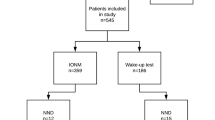Abstract
Purpose
Patients with neuromuscular scoliosis are at increased risk of neurological deficit post-operatively, but are a difficult population on whom to perform neurophysiological monitoring. We look here at a 7-year sample of our practice in the monitoring of neuromuscular patients.
Methods
A retrospective chart review was performed for 109 patients who underwent correction of neuromuscular scoliosis within our institution between 2005 and 2011.
Results
Of 109 patients who were identified, intraoperative monitoring was attempted in 66 cases. In eight cases (13 %), no reliable monitoring could be achieved and was therefore abandoned. On nine occasions, there was a significant drop in at least one modality intraoperatively. None of these nine suffered any clinically observable neurological deficit post-operatively. Of the 109 patients, 2 had clinically detectable deficits post-operatively, both of whom had undergone normal intraoperative monitoring.
Conclusions
The two patients with observable deficit had their instrumentation left in situ after discussion with them and/or parents. Spinal cord monitoring in this population is possible but potentially unreliable. Surgeons will need to carefully consider the use of monitoring in their management of this challenging population.

Similar content being viewed by others
References
Sarwark J, Sarwahi V (2007) New strategies and decision making in the management of neuromuscular scoliosis. Orthop Clin N Am 38:485–496
Jones KB, Sponseller PD, Shindle MK et al (2003) Longitudinal parental perceptions of spinal fusion for neuromuscular spine deformity in patients with totally involved cerebral palsy. J Pediatr Orthop 23:143–149
Comstock CP, Leach J, Wenger DR (1998) Scoliosis in total-body involvement cerebral palsy: analysis of surgical treatment and patient and caregiver satisfaction. Spine 23:1412–1425
Fehlings MG, Kelleher MO (2007) Intraoperative monitoring during spinal surgery for neuromuscular scoliosis. Nat Clin Pract Neurol 3:318–319
Nuwer MR, Dawson EG, Carlson LG et al (1995) Somatosensory evoked potential spinal cord monitoring reduces neurologic deficits after scoliosis surgery: results of a large multicenter survey. Electroencephalogr Clin Neurophysiol 96:6–11
DiCindio S, Theroux M, Shah S et al (2008) Multimodality monitoring of transcranial electric motor and somatosensory-evoked potentials during surgical correction of spinal deformity in patients with cerebral palsy and other neuromuscular disorders. Spine 28(16):1851–1856
Eccher M (2012) Intraoperative neurophysiologic monitoring: are we really that bad? J Clin Neurophysiol 29(2):157–159
DiCindio S, Theroux M, Shah S, Miller F, Dabney K, Brislin RP, Schwartz D (2003) Multimodality monitoring of transcranial electric motor and somatosensory-evoked potentials during surgical correction of spinal deformity in patients with cerebral palsy and other neuromuscular disorders. Spine (Phila Pa 1976) 28(16):1851–1855
Ecker ML, Dormans JP, Schwartz DM et al (1996) Efficacy of spinal cord monitoring in scoliosis surgery in patients with cerebral palsy. J Spinal Disord 9:159–164
Padberg AM, Russo MH, Lenke LG et al (1996) Validity and reliability of spinal cord monitoring in neuromuscular spinal deformity surgery. J Spinal Disord 9:150–158
DiCindio S, Theroux M, Shah S, Miller F, Dabney K, Brislin RP, Schwartz D (2003) Multimodality monitoring of transcranial electric motor and somatosensory-evoked potentials during surgical correction of spinal deformity in patients with cerebral palsy and other neuromuscular disorders. Spine 16:1851–1856
Ashkenaze D, Mudiyam R, Boachie-Adjei O et al (1993) Efficacy of spinal cord monitoring in neuromuscular scoliosis. Spine 18:1627–1633
Quraishi NA, Lewis SJ, Kelleher MO et al (2009) Intraoperative multimodality monitoring in adult spinal deformity: analysis of a prospective series of one hundred and two cases with independent evaluation. Spine 34(14):1504–1512
Conflict of interest
None.
Author information
Authors and Affiliations
Corresponding author
Rights and permissions
About this article
Cite this article
Hammett, T.C., Boreham, B., Quraishi, N.A. et al. Intraoperative spinal cord monitoring during the surgical correction of scoliosis due to cerebral palsy and other neuromuscular disorders. Eur Spine J 22 (Suppl 1), 38–41 (2013). https://doi.org/10.1007/s00586-012-2652-x
Received:
Revised:
Accepted:
Published:
Issue Date:
DOI: https://doi.org/10.1007/s00586-012-2652-x



